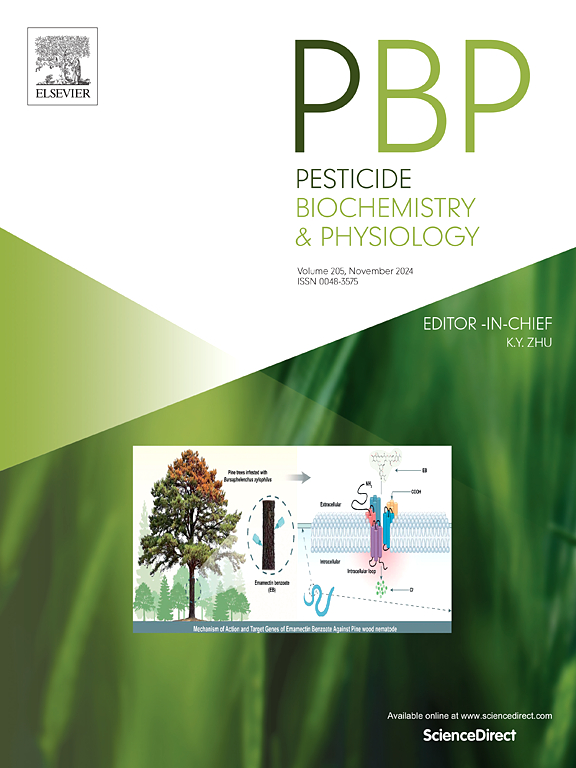Synergistic effect of β-ocimene on Hyphantria cunea sex pheromone and its potential attraction mechanism related to Ca2+ stimulation
IF 4.2
1区 农林科学
Q2 BIOCHEMISTRY & MOLECULAR BIOLOGY
引用次数: 0
Abstract
Hyphantria cunea, a globally significant quarantine pest, causes severe ecological and economic impacts in invaded regions. Attractants are environment-friendly and valuable pest management tools for H. cunea control. In this study, we identified that the combination of β-ocimene with sex pheromone components was strongly attractive to H. cunea males. This attractant combination activates the Ras signaling pathway and stimulates Ca2+ in male adults following exposure. Feeding and oviposition behavior results demonstrated that H. cunea prefers Morus alba over Platanus × acerifolia, Metasequoia glyptostroboides, and Taxodium distichum. In the fresh branches of M. alba with leaves, the relative abundance of β-ocimene (36.33 ± 0.41 %) was significantly higher than the other hosts. Electroantennography recordings, behavioral choice assays, and field trapping trials showed that the combination of β-ocimene with sex pheromone components significantly enhanced male response and attraction. The number of trapped males using β-ocimene/ sex pheromone blend was 3.7-fold higher than that of sex pheromone or β-ocimene alone in the field, indicating a synergistic effect of adding β-ocimene to sex pheromone. The molecular mechanism of β-ocimene/sex pheromone synergism was further analyzed. After exposure to the attractant, the Ras signaling pathway in the heads of males are activated (HcILP and HcPLCε1 are upregulated, while HcRasGAP and HcPLD are downregulated), which further stimulates the expression of IP3 and Ca2+. The activation of Ca2+ may be the key reason for its higher attraction to males. These findings provide a theoretical basis for the selection and mechanistic understanding of attractants for H. cunea, offering insights for attractant-based pest control strategies.

求助全文
约1分钟内获得全文
求助全文
来源期刊
CiteScore
7.00
自引率
8.50%
发文量
238
审稿时长
4.2 months
期刊介绍:
Pesticide Biochemistry and Physiology publishes original scientific articles pertaining to the mode of action of plant protection agents such as insecticides, fungicides, herbicides, and similar compounds, including nonlethal pest control agents, biosynthesis of pheromones, hormones, and plant resistance agents. Manuscripts may include a biochemical, physiological, or molecular study for an understanding of comparative toxicology or selective toxicity of both target and nontarget organisms. Particular interest will be given to studies on the molecular biology of pest control, toxicology, and pesticide resistance.
Research Areas Emphasized Include the Biochemistry and Physiology of:
• Comparative toxicity
• Mode of action
• Pathophysiology
• Plant growth regulators
• Resistance
• Other effects of pesticides on both parasites and hosts.
文献相关原料
公司名称
产品信息
阿拉丁
3-Carene

 求助内容:
求助内容: 应助结果提醒方式:
应助结果提醒方式:


